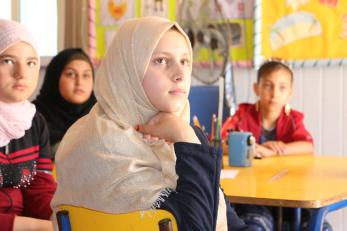Mercy Corps resumes the Cultural Heritage Program after COVID-19 lockdown

The rollout of strict and prolonged restrictions on movements and activities in Jordan’s refugee camps, as a result of COVID‑19, has taken its toll on both refugees and vulnerable Jordanians, who saw their access to psychosocial support, educational and recreational activities, and social interaction with their peers severely restricted.
In Mid-June, 2021, the government of Jordan announced the reopening of Za’atari and Azraq Camps allowing program activities to resume with 50% capacity. This came as a relief to the Za’atari camp’s population. Accordingly, Mercy Corps continued to master its art in tailoring activities to the interests of the Syrian community by connecting children and their families with Syria’s rich cultural heritage by means of art, music, and handicraft activities through the Cultural Heritage Program. The aim of the Cultural Heritage Program is helping to restore the damage caused to the wellbeing of children and youth by the experience of war and refuge. It also seeks to strengthen family cohesion and communication.
Rayan Al Hariri, a 12 years old girl from Za’atari Camp who was one of the first adolescent participants to return to Mercy Corps’ site, tells her story. As she was playing at the playground of Mercy Corps’ Dreamland site, she noticed a teacher called “Um Hanan '' explaining a lesson for girls about the Syrian cultural heritage. Rayan liked the program and felt excited about joining it; she then provided Mercy Corps’ field staff with her parents’ number to receive their approval for her enrollment. Upon contacting Rayan’s parents and briefing them about the program, her parents were interested and so Rayan joined the Cultural Heritage Program.
Since day one of her attendance the teachers noticed Rayan’s enthusiasm and positive interaction with the sessions’ content and with her classmates. Rayan mentions: “What I loved most from the sessions is learning about the traditions and customs of my own region and the archaeological sites that exist in my hometown, which is famous for its industries and customs as well. Through the activities, I began to form new friendships and started to love teamwork especially during my participation in arts and handicrafts sessions.”

According to her teachers, Rayan has a curious and cheerful personality who participates actively by asking many questions in the cultural heritage sessions. Rayan is a wonderful girl who loves to help, loves those around her and loves her family very much.
Rayan says: “I cherish all what I have done during the practical arts and handicrafts sessions, therefore, I’m keeping all the work I have made myself in the caravan, including mosaics, embroidery, and the Syrian house, which I’m proud to have made myself”.
Cultural heritage interventions help ground youth in their own culture that they have not had the opportunity to experience or feel connected to as refugees. Mercy Corps believes in the importance of a community’s cultural traditions to help rebuild social networks and maintain a connection to their home country.
The Cultural Heritage Program is part of Mercy Corps’ ISHRAK program. ISHRAK supports the physical, emotional, and social wellbeing of individuals through a wide variety of structured and non-structured activities. These include a safe space to play, cultural heritage lessons, art, filmmaking, and parenting programs, among others. These programs are designed to spark creativity, and build confidence, skills, and positive relationships between children and older family members, while ensuring that Syrian refugee young people have a connection to their homeland that is a source of pride and strength.